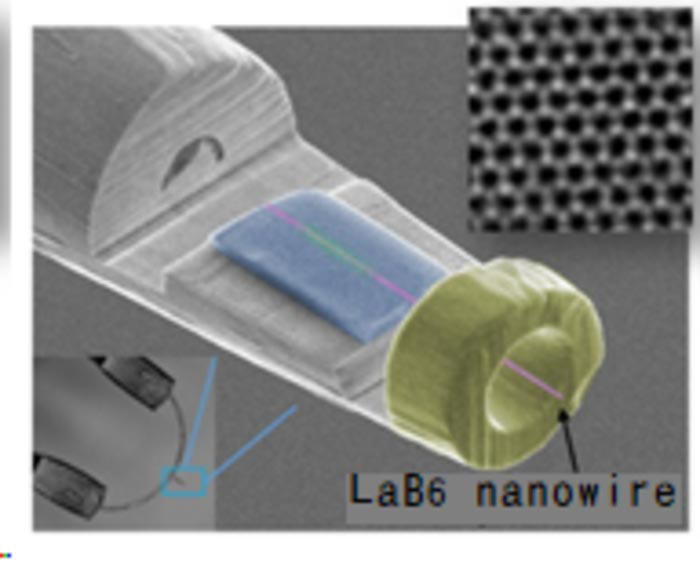Development of a high-energy-resolution, LaB6 nanowire-based field emission gun

SEM image of the LaB6 nanowire-based electron source. An atomic resolution image of single-layer graphene taken by a TEM equipped with this electron source is shown in the boxed image at upper right.
Credit: Koji Kimoto National Institute for Materials Science Tel: +81-29-860-4402 Email: KIMOTO.Koji@nims.go.jp Zhang Han National Institute for Materials Science Email: Zhang.han@nims.go.jp
Electron source enables atomic resolution TEM observation.
The National Institute for Materials Science (NIMS) and JEOL, Ltd. have developed a lanthanum hexaboride (LaB6) nanowire-based field emission gun that is installable on an aberration-corrected transmission electron microscope (TEM). This combined unit is able to perform atomic resolution observation at an energy resolution of 0.2 eV—the highest resolution ever recorded for non-monochromatic electron guns—with a high current stability of 0.4%.
Unsuccessful efforts have been made for more than 20 years to develop field emission guns using theoretically high-performance nano materials. It has been found challenging to integrate a nanowire-based field emission gun into an electron microscope without undermining its physical properties, such as lives and stability. For this reason, commercially available field emission guns are still equipped with tungsten needles developed more than half a century ago.
This NIMS-JEOL research team 1) developed techniques to chemically synthesize and grow high-purity, single-crystal nanowires of LaB6, known to be an excellent electron-emitting hot cathode material, 2) designed an electron source mechanism capable of efficiently emitting electrons and 3) developed techniques to extract a single nanowire and integrate it into an optimized electron source structure.
The LaB6 nanowire-based electron source has a number of advantages: relatively moderate vacuum condition requirements, very high current stability, low extraction voltage, narrow electron beam energy distribution width and high brightness. This electron source may be applicable to the development of next-generation field emission electron microscopes with higher spatial and energy resolution—potentially valuable tools in the semiconductor and medical fields.
This project was carried out by a team of NIMS researchers (Han Zhang, Cretu Ovidiu, Koji Kimoto, Takeshi Kasaya, Hideki T. Miyazaki, Naohito Tsujii, Hongxin Wang, Yasushi Yamauchi and Daisuke Fujita) and JEOL researchers (Yu Jimbo, Akira Niwata, Akihiro Ikeda, Akira Yasuhara, Shin-ichi Kitamura and Hironobu Manabe).
This research was published in the online version of Nature Nanotechnology on November 9, 2021, Japan Time (DOI: 10.1038/s41565-021-00999-w).
Journal: Nature Nanotechnology
DOI: 10.1038/s41565-021-00999-w
Method of Research: Experimental study
Subject of Research: Not applicable
Article Title: High-endurance Micro-engineered LaB6 Nanowire Electron Source for High-resolution Electron Microscopy
Article Publication Date: 9-Nov-2021
Original Source
https://www.nims.go.jp/eng/news/press/2021/11/202111090.html
All latest news from the category: Materials Sciences
Materials management deals with the research, development, manufacturing and processing of raw and industrial materials. Key aspects here are biological and medical issues, which play an increasingly important role in this field.
innovations-report offers in-depth articles related to the development and application of materials and the structure and properties of new materials.
Newest articles

Innovative 3D printed scaffolds offer new hope for bone healing
Researchers at the Institute for Bioengineering of Catalonia have developed novel 3D printed PLA-CaP scaffolds that promote blood vessel formation, ensuring better healing and regeneration of bone tissue. Bone is…

The surprising role of gut infection in Alzheimer’s disease
ASU- and Banner Alzheimer’s Institute-led study implicates link between a common virus and the disease, which travels from the gut to the brain and may be a target for antiviral…

Molecular gardening: New enzymes discovered for protein modification pruning
How deubiquitinases USP53 and USP54 cleave long polyubiquitin chains and how the former is linked to liver disease in children. Deubiquitinases (DUBs) are enzymes used by cells to trim protein…



